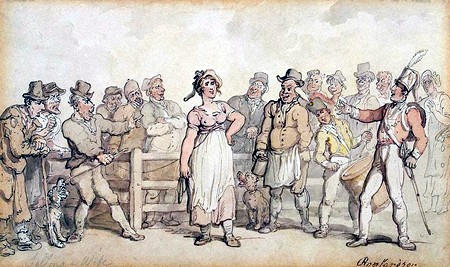|
Wife selling

One of the more disturbing
episodes from English literature is the sale of a wife which is described
in the 19th century novel The Mayor of Casterbridge, an incident which
shocked and intrigued Victorian society. The eponymous hero Michael
Henchard, then a humble journeyman hay trusser, is spurred on by alcohol
when he auctions his wife and baby daughter to a sailor for five guineas
but next day, when sober and full of remorse, it is too late to recover
his family.
Thomas Hardy wrote the book in 1886 as part of his Wessex novels set in a
fictional rustic England but he is known to have drawn many characters and
incidents from life and so there is all probability that the sale of a
wife actually happened somewhere in the country at that time and may even
have been reported by the local newspapers.
The English custom of wife selling began in the late 17th century when
divorce was a practical impossibility for all but the very wealthiest. The
town crier or bellman was known to announce such events and after parading
his wife with a halter around her neck, arm, or waist, often adorned with
ribbons, a husband would publicly auction her to the highest bidder.
Although the procedure had no basis in law and frequently resulted in
prosecution, particularly from the mid-19th century onwards, the attitude
of the authorities was confusing. At least one magistrate is on record as
stating that he did not believe he had the right to prevent wife sales and
there were cases of local Poor Law Commissioners forcing husbands to sell
their wives, rather than having to maintain the family in workhouses.
The custom of wife selling spread to Wales, Scotland, Australia and then
to the United States before dying out in the early 20th century. It was
not unknown in Lincolnshire and there is even evidence of a case here in
Bourne some sixty or more years before Thomas Hardy’s fictional account
but the incident so shocked the local newspaper that the editor refused to
print it although he did publish sufficient information to establish that
it did actually happen.
The report was filed to the Stamford Mercury by their Bourne
correspondent who claimed that the transaction took place on Saturday 29th
April 1820 and the following Friday, May 5th, this report appeared in the
newspaper: “The dealing parties are represented to be a native of
Rippingale and a tradesman of Bourne: the scorn of every decent person
will reprove them. As this is a case in which we are not hampered by the
consideration due to an advertisement, and have therefore a full option,
we shall decline publishing the disgusting particulars; and we shall
embrace the opportunity of saying a few words for ourselves respecting
some advertisements that have lately stained our columns.
“In whatever comes to us as an announcement that is to be paid for, it is
considered to be our duty to allow the utmost latitude to the public that
is consistent with our own legal safety; and the use which is made of the
privilege by some persons, should not lead others to conclude that we
catch at scurrility for profit: we are sensible of the pollution which
some matters give to our pages, and would gladly, if we could, avoid it.
The situation of the conductor of a newspaper is always arduous and
dangerous, and often painful.”
The belief that a wife could be disposed of by means of a public sale was
therefore well entrenched in folklore although the last known case in the
county occurred in 1852 when the Stamford Mercury reported on
Friday 2nd January: “Sale of a wife – a barbarous exhibition of this kind
took place in Spalding market on Tuesday last. A notion prevalent amongst
the ignorant, that by this means a husband gets rid of his liability to
maintain a disagreeable partner.”
No further details were given, indicating yet again the attitude of the
newspaper and, indeed, the public at large.
NOTE: The watercolour drawing by Thomas
Rowlandson (1812-14) "Selling a wife"
is reproduced courtesy Wikipedia.
Return to
Strange but true

Go to:
Main Index Villages
Index
|
